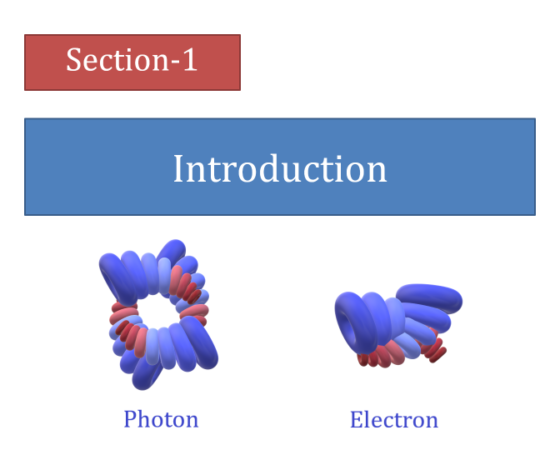Introduction: (Watch Video)
To find out the real essence which can solve the puzzles created by the experimental facts and their theoretical interpretations regarding the building blocks of the Universe, it is very essential to understand the basic nature of the building blocks. Presently known building blocks of the Universe are leptons, quarks and bosons along with dark energy and dark matter.
Electromagnetic Radiation (Photon):
Experimental Facts (about EMR/Photon):
Electromagnetic radiation (EMR or photon) of the definite frequency is made up of the definite quanta of energy (qE).
The velocity of the photon is decreased during its movement from the low-mass density medium to the high mass density medium.
When two photons of different qE (and frequencies) pass from any medium, the velocity of the photon with higher qE is less as compared to the velocity of the photon with lower qE.
It is also experimentally proven that during the propagation of EMR, it produces oscillating electric fields and magnetic fields in space/medium.
Indications (about EMR/Photon):
Though as per the traditional hypothesis, the photon is considered as massless, from the experimental facts, it can be hypothesized that along with the qE, the photon possesses the definite quanta of mass (qM) which is made up of dark matter.
As dark matter cannot be measured by the commonly used experimental techniques, the presence of qM within photon can only be confirmed by velocity difference during propagation of photon from one medium to another medium and propagation of two photons having different qE within the same medium.
During the propagation of a photon through any medium, qM of photon interacts with the dark matter present within that medium. Due to the attraction forces in between the dark matter of photon and medium, the photon finds resistance during its movement.
During the propagation of Photon from rarer medium to denser medium, it finds more resistance due to increment in attraction forces in between qM of photon and denser medium as compared to rarer medium.
Among two photons having different qE, the photon having higher qE along with higher qM faces more resistance to its movement due to the higher attraction force of the medium for that photon as compared to another photon having lower qE.
Electrons and their energy levels:
Experimental Facts (about Electrons and their energy levels):
It is also experimentally derived that an Electron has certain mass as well as charge. Within an atom, Electrons are present outside the Nucleus within the definite energy levels. It is also derived that by absorption or emission of the certain qE, Electron moves from one energy level to another energy level within the atom.
Within a normal (non-radioactive) atom, Electrons are not captured by the Nucleus, though as per the current hypothesis, in between the Electrons and the Nucleus; there is an empty space (vacuum) which cannot obstruct the movement of Electrons (having definite mass and negative charge) towards the most massive Nucleus (having positive charge). So, theoretically within the normal atom, gravitational force and force exerts between two opposite charges favor not only the direction of movement of Electron towards Nucleus but also its capture within the Nucleus, practically this phenomenon never happens within the normal atom.
Indications (about Electrons and their energy levels):
From the experimental facts about electrons and their energy levels, it can be indicated that each energy level (of Electron) possesses the definite quanta of energy (in form of dark energy) along with definite quanta of mass (in form of dark matter) within its unit volume.
The energy levels proximal to the Nucleus certainly possess quanta of mass in very high mass density as compared to the energy levels far from the nucleus. This hypothesis is based on the axiom that the dark matter can be attracted by the strong gravitational force of the Nucleus.
Further, it is also hypothesized that as the distance of dark matter from the nucleus is increased, the gravitational force on the nucleus decreases proportionally. So, the mass density of dark matter present within the energy levels far from the Nucleus is lesser as compared to the energy levels present nearby the Nucleus.
Therefore, from the above hypothesis, it can be derived that each energy level has a specific mass density of dark matter. The mass density of these layers changes with the change in their relative distance from the Nucleus.
So, by considering the above interpretation, when Electron absorbs the photon having definite qE, it moves from the lower energy level having the higher mass density of dark matter to the higher energy level having the lower mass density of dark matter.
By further simplification of this hypothesis, it can be derived that within any atom, the inner energy layers possess the lesser tqE (total quanta of energy)/ tqM (total quanta of mass), the lesser volume, the higher mass density and higher energy pressure as compared to the outer energy layers.
As an Electron absorbs the photon of definite qE at the ground state, the tqE/tqM is increased within the Electron along with the increment in its volume and the decrement in its mass density, so it moves from ground state to excited state.
As an Electron emits the photon of definite qE at the excited state, the tqE/tqM is decreased within the Electron along with the decrement in its volume and the increment in its mass density, so it moves from the excited state to ground state.
It can be derived from the above interpretation that like other thermodynamic systems, changes in the tqE within the Electron could be reflected by the changes in volume along with the changes in mass density and/or by the changes in energy pressure.
In the ground state, the Electron has lower tqE/tqM, lower volume, higher mass density and higher energy pressure as compared to its excited state.
Further, it is also derived that higher tqE/tqM of Electrons present in any energy level as compared to their Nucleus is responsible for the separate identity of electrons outside of the Nucleus within the atom.
Traditionally, it is considered that the Electron is a point-like particle having no substructure.
But by the integration of the all above interpretations, it can be hypothesized that electron possesses definite tqM and definite tqE along with certain volume, shape, mass density and energy pressure during its presence in the definite energy layer.
The same hypothesis can also be extrapolated for all other subatomic particles.


